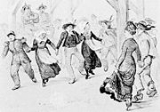
Gavotte
Overview
France
The French Republic , The French Republic , The French Republic , (commonly known as France , is a unitary semi-presidential republic in Western Europe with several overseas territories and islands located on other continents and in the Indian, Pacific, and Atlantic oceans. Metropolitan France...
folk dance
Folk dance
The term folk dance describes dances that share some or all of the following attributes:*They are dances performed at social functions by people with little or no professional training, often to traditional music or music based on traditional music....
, taking its name from the Gavot people of the Pays de Gap region of Dauphiné
Dauphiné
The Dauphiné or Dauphiné Viennois is a former province in southeastern France, whose area roughly corresponded to that of the present departments of :Isère, :Drôme, and :Hautes-Alpes....
, where the dance originated. It is notated in 4/4 or 2/2 time
Time signature
The time signature is a notational convention used in Western musical notation to specify how many beats are in each measure and which note value constitutes one beat....
and is of moderate tempo
Tempo
In musical terminology, tempo is the speed or pace of a given piece. Tempo is a crucial element of any musical composition, as it can affect the mood and difficulty of a piece.-Measuring tempo:...
. The distinctive rhythmic feature of the 18th-century French court gavotte is that phrases begin in the middle of the bar; that is, in either 4/4 or 2/2 time, the phrases begin on the third quarter note
Quarter note
A quarter note or crotchet is a note played for one quarter of the duration of a whole note . Often people will say that a crotchet is one beat, however, this is not always correct, as the beat is indicated by the time signature of the music; a quarter note may or may not be the beat...
(crotchet) of the bar, creating a half-measure (half-bar) upbeat, as illustrated below:
On the contrary, the music for the earlier court gavotte, first described by Thoinot Arbeau
Thoinot Arbeau
Thoinot Arbeau is the anagrammatic pen name of French cleric Jehan Tabourot . Tabourot is most famous for his Orchésographie, a study of late sixteenth-century French Renaissance social dance...
in 1589, invariably began on the downbeat of a duple measure, and the various folk gavottes found in mid-20th century Brittany were danced to music in 4/4, 2/4, 9/8, and 5/8 time.
Unanswered Questions
Discussions

